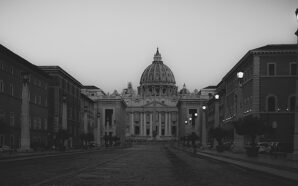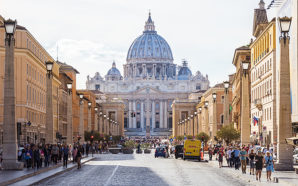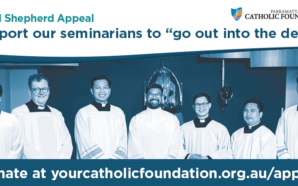The Catholic Church in Australia observed Child Protection Sunday on 10 September 2017.
Child Protection Sunday, 10 September 2017
Throughout this last week (3-9 September), National Child Protection Week has invited all Australians to play their part to promote the safety and wellbeing of children and young people. The week, now in its 27th year, supports and encourages the safety and wellbeing of Australian children and families. This year the National Association for Prevention of Child Abuse and Neglect has focused on the theme ‘Stronger Communities, Safer Children.’ As the Association proposes,
This theme emphasizes the importance and value of connected communities in keeping children and young people safe and well. Communities in which children are seen and heard, where their participation is valued and where their families can get the support they need are stronger communities which contribute to keeping children safe and well.[1]
The National Committee for Professional Standards, a committee of the Australian Catholic Bishops and Catholic Religious Australia, has subsequently put before us the theme, “See Me, Hear Me” for this Sunday when we commemorate the importance of the safety of children in our community of faith. With what commitment do we take notice of our children’s safety? With what responsibility do we seek to ensure that our communities are places of safety for them?
Related coverage: Child Protection Sunday
Related coverage: Safeguarding Support for Ministry
Related coverage: Driving a cultural shift
Children are the delight both of our families and our communities. When we gaze upon a child we are caught intensely between an immediate experience of the present and a heightened expectation of the future, between a “fulfilled moment and the beginning of a new day.”[2] As another German writer, Jürgen Moltmann, beautifully expresses it,
Childhood and youth are . . . transfigured with the daybreak colours of the dawn of life . . imagined childlike innocence, this image of the pure beginning, this world of unlimited possibilities – all this makes childhood the image of hope . . . and when we search for ‘the child in us’ it is because we long to open this wellspring in ourselves once more.[3]
In every child, God waits for us to stir again within us the sense of new beginnings, of fresh possibilities, of awakening hopes. In the wonder of children our concern gives way; in their excitement, our pressure is relieved; in their play, our compulsiveness is disarmed. Every child is the sign of life’s hope of ever new beginnings. They are the future in anticipation. Is it surprising that Emerson once observed, that each child is the eternal messiah who returns again and again among fallen men and women, to lead us into the kingdom of heaven?[4]
Yet, sadly we know that the innocence of youth has not always been treasured and protected in our community. For nearly thirty years now we have been subjected to the constant exposure of the way in which, in certain circumstances, that innocence has been betrayed, and in many cases destroyed. The litany of complaints of the sexual abuse of children within our community has become a wound that has yet to discover its healing. Waiting upon the Final Report of the Royal Commission into Institutional Responses to Child Sexual Abuse, we have been forced to move beyond a consideration that such disclosures are about the criminal behaviour of a few. We are no longer afforded the delusion that these disclosures are just about the failings of a few that bring shame to us all. It is critical for us as we enter this moment with the greatest humility, that we are ready to be radically self-reflective, eager to learn, open to conversion. If we can truly learn, amongst other things: the lessons of what contributes to cultures of abuse and be honest about those efforts required to embark upon cultural change; if we can learn better those processes of transparent examination when incidents of abuse might occur; if we can truly hear the deepest needs of those who have been abused and better distinguish between the criminal, the legal and the pastoral; and if we can learn the kind of leadership that this moment genuinely requires – then what is a deep wound might indeed become a source of new life, as the Reading from the Prophet Ezekiel (Ez 33: 7-9) today intimates.
Related coverage: Child Protection Sunday
Related coverage: Safeguarding Support for Ministry
Related coverage: Driving a cultural shift
The outcome of such learning will be growth in our identity as communities of reconciliation, genuine Resurrection communities, to which the Gospel of Matthew today (Matt 8:15-20) impels us. The American pastoral theologian, Robert Schreiter, suggests the template that might underscore such a reconciled community be found in the 21st chapter of the Gospel of John.[5] It is the familiar scene of Jesus meeting his disciples by the sea as they fish. The story begins in a climate of rupture, in an experience of alienation and fragmentation. In their disenchantment with all that has occurred through the apparent failure of Jesus, the disciples are attempting to return to the normalcy of their life but without success. They try to fish but nothing works. They continue to carry the heavy burdens of the past. It is here where Jesus meets them. This stance of Jesus suggests, according to Schreiter, that our life of reconciliation, begins with our readiness to be available to people where they are, to journey with them in whatever place of hurt and exclusion they may be experiencing, This kind of accompaniment is marked by a listening patience that allows the other to reveal that which is a burden, even when the person might not be articulate about what that burden is, and why it weighs so heavily. But Jesus doesn’t simply meet the disciples. He goes much further. He cooks the disciples breakfast. He demonstrates hospitality. This hospitality carries with it a sense of both graciousness and spaciousness – an abundance that will act, in time, to invite a new way of thinking about possibilities. Through accompaniment, hospitality, facilitating connections, and commissioning one another, in Resurrection light and grace, we enable those communities of reconciliation, about which Matthew’s Gospel speaks, to spring up. According to Shreiter, communities of reconciliation, resurrection communities, are ‘communities of safety’ where people can explore their wounds and experience the safety to rebuild their trust in life. They are ‘communities of memory’ where memory can be retrieved in a redemptive way. And they are ‘communities of hope’ from which people can go forth empowered, commissioned to bring forth life in abundance.[6]
Becoming such a community of reconciliation and Resurrection, as in Matthew’s framework, is not an instant project. It occurs in our commitment to see and to hear particularly those who are vulnerable, and those whose voice is too often overlooked. The Jewish mystic and feminist, Simone Weil, recounted in one of her insightful essays that in the first legend of the Holy Grail, it is said that the Grail belongs to the first comer who asks the guardian of the vessel, a king three quarters paralyzed by the most painful wound, “What are you going through?”[7] Only when Parsifal has learnt how to ask this question is he ready to receive the Grail, that the king once paralyzed retrieves his health, and vitality is restored to the land. In Weil’s words, only when Parsifal has learnt how to attend to the other, not just as a unit in a collection, or a specimen from the social category labeled ‘unfortunate’ (or ‘as too small’ as in our case today) but as a person, only when he has learnt how to gaze upon the other full of attention, emptying himself of his own agenda to receive the truth of the person he is encountering, does true healing occur for the kingdom. The theme of our Child Protection Sunday calls us to this radical attitude of spirit. Simone Weil illustrates in her discussion that the capacity to give this kind attention to another is a very rare and difficult thing: it is almost a miracle, it is a miracle. And yet it is the key to healing. Weil thus presents us a metaphor for our own healing in the face of the experience of the wound at the heart of our life as Church. It is only as we learn to encounter persons, and especially our children, full of attentiveness, asking, beyond mere warmth of heart, impulsiveness and pity, “what are you going through?” that new horizons can possibly disclose themselves for it. The alternative is to be paralyzed with a kingdom in decay.
Related coverage: Child Protection Sunday
Related coverage: Safeguarding Support for Ministry
Related coverage: Driving a cultural shift
Conversation begins with a listening heart. Listening reveals our desire to learn and to grow through understanding the wisdom others offer – especially the young, for as St Benedict reminded us in the 6th century, “the Lord often reveals what is better to the younger” (RB 3:2). It involves the suspension of our viewpoint to attempt to truly hear and understand another. Listening is a complex process, and we need to develop our listening skills to be able to sort through all we might hear to get to the essential truth of a situation. Yet, where there is little to no listening, the community spirals into dysfunction. The presence or absence of listening, especially to the young and to those who are vulnerable, acts as the barometer of our health and vitality as a Church.
With a listening heart, our heart that sees and hears, we are called to enter a conversation which might become a means of conversion, a different way of acting. The Royal Commission, itself, in its own commitment to change society, has sought to do this by listening to the accounts of more than 1400 young Australians about their own experience of safety. It revealed that change for the greater protection of our most vulnerable will occur only as we respect them, ask what they are going through, watch what others are doing regarding them, listen to what they are trying to tell us, do what we are supposed to do for them, inform them about danger, and stand up and speak out for them. In so doing, we maintain our most treasured within a strong experience of connection, within the nurturing bonds of community – the caliber of the truly Christian community about which the Gospel of Matthew proposes to us today.
By Fr David Ranson, Vicar General, Diocese of Broken Bay.
[1] NAPCAN: Prevent Child Abuse and Neglect, http://napcan.org.au/ncpw/
[2] Jürgen Moltmann, In the End – The Beginning: The life of hope, translated by Margaret Kohl, (Minneapolis: Fortress Press, 2004, 8.
[3] Moltamnn, In the End – The Beginning, 10.
[4] Cited in Motlmann, In the End – The Beginning, 15.
[5] Robert Schreiter, The Ministry of Reconciliation: Spirituality and Strategies, (Maryknoll: Orbis Books, 1999), 83-96.
[6] Refer Schreiter, The Ministry of Reconciliation¸ 94-95.
[7] Simone Weil, “Attention and the Right Use of School Studies,” in Waiting for God, (London: Routledge & Kegan Ltd, 1951)








